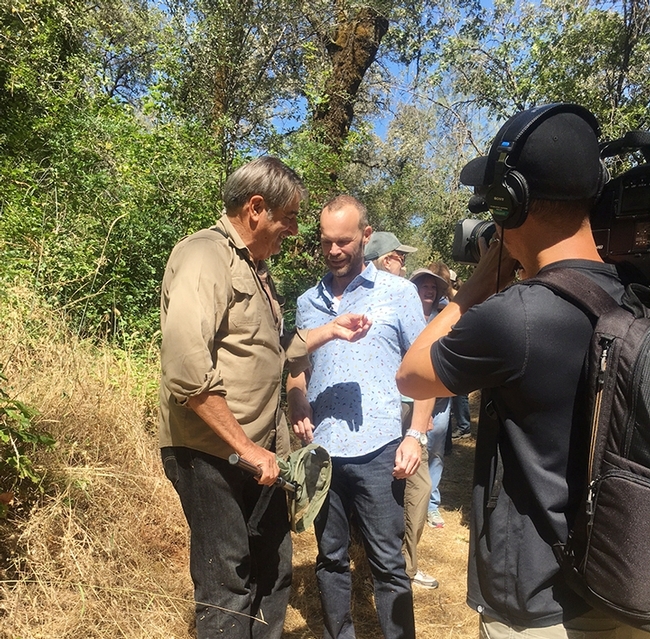- Author: Kathy Keatley Garvey

In celebrating the California dogface butterfly, Zerene eurydice, visitors at the Bohart Museum of Entomology open house learned about the biology and history of the insect, engaged in arts and crafts, and enjoyed two specially decorated sheet cakes, one featuring the male dogface butterfly and the other, the female.
The occasion: the 50th anniversary of the year that the California State Legislature designated the California dogface butterfly as the state insect. Most attending the open house have never seen the butterfly in the wild.
The dogface butterfly, found only in California, thrives at its major breeding ground, the Shutamul Bear River Preserve in Auburn, a private preserve maintained by the Placer Land Trust (PLT). It's there because its host plant, false indigo, Amorpha californica, is there--amid the steep canyons, wildflowers poison oak and other vegetation.
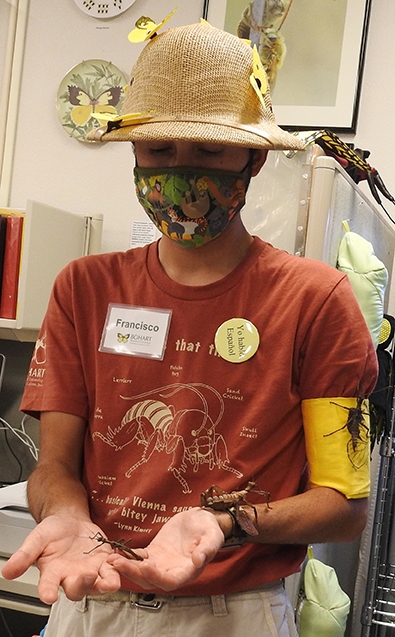
Kareofelas, who has reared multiple dogface butterflies from egg to caterpillar to chrysalis to adult, showed a PowerPoint of images he captured of the life cycle and discussed the history and biology of the butterfly. He serves as a volunteer docent for PLT.
Communications specialist Julia Boorinakis Harper Barbeau of Placer Land Trust narrated a video and staffed a table with fellow PLT'ers Carole Gan and CollinHobb. Among others participating was naturalist and PLT docent volunteer Deren Ross, credited with finding the first dogface butterfly at the Shutamul Bear River Preserve. (See PLT news story)
UC Davis students and Bohart volunteers Danielle Sion and Amberly Hackmann encouraged the guests to make yellow felt butterflies, ornaments for their shoes, hair, belt and wrists. Guests also crafted caterpillar puppets. A stick insect at the Bohart Museum petting zoo, took the opportunity to walk on one of the caterpillar puppets.
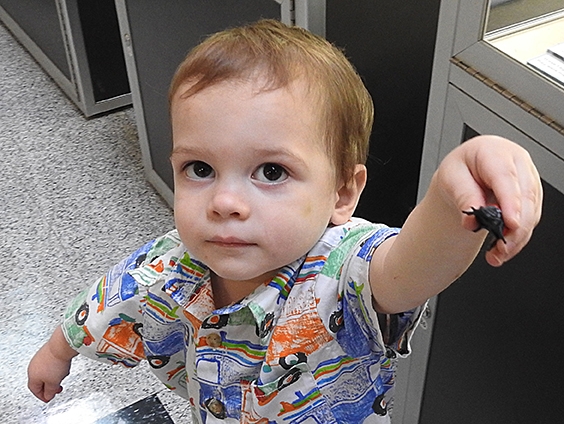
Entomologist Jeff Smith, curator of the Lepidoptera collection, showed specimens, including dogface butterfly, monarch, morpho and viceroy specimens, and answered questions.
Meanwhile, entomologist and Bohart lab assistant Brennen Dyer staffed the gift shop. A budding entomologist named Chip, 2, of Woodland, showed off his newly purchased bug habitat cage and some toy critters.
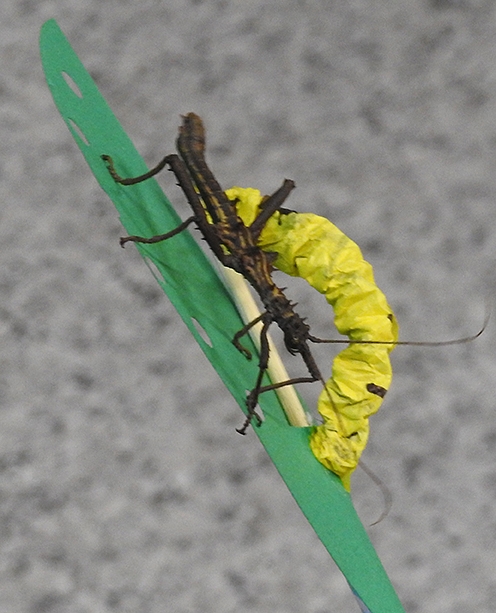
The Bohart Museum, directed by UC Davis distinguished professor Lynn Kimsey, houses a global collection of eight million insect specimens. It also maintains a live petting zoo and an insect-themed gift shop (including T-shirts, hoodies, books, jewelry, posters, collecting equipment).
The next Bohart Museum open house will be the annual Moth Night, held in observance of National Moth Week. The open house will be both indoor and outdoor from 8 p.m. to 11 p.m., Saturday, July 30. The event is free and family friendly, and visitors are encouraged to explore the world of moths in the Bohart's research collection and to see what lands on backlighting display: a hanging white sheet, illuminated by ultraviolet (UV) light and powered by a generator. The backlighting display will be a short, walking distance from the museum.
This summer the Bohart Museum is open to the public Monday through Thursday from 9 a.m. to noon and from 1 to 5 p.m., but groups must make reservations and all must follow the UC Davis visitor guidelines: https://campusready.ucdavis.edu/visitors?.
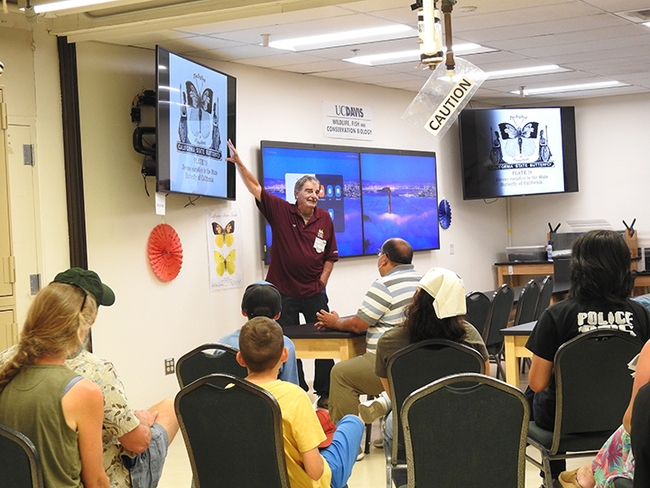
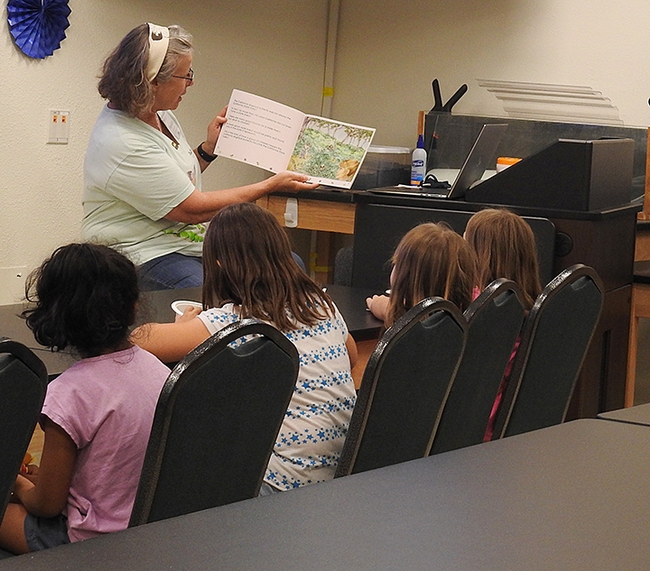
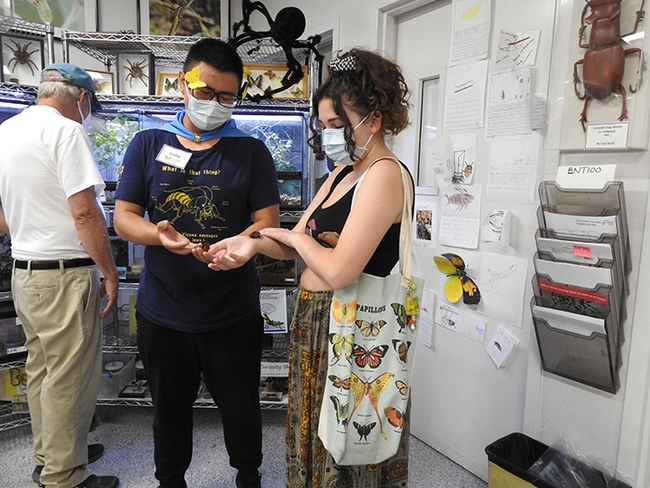
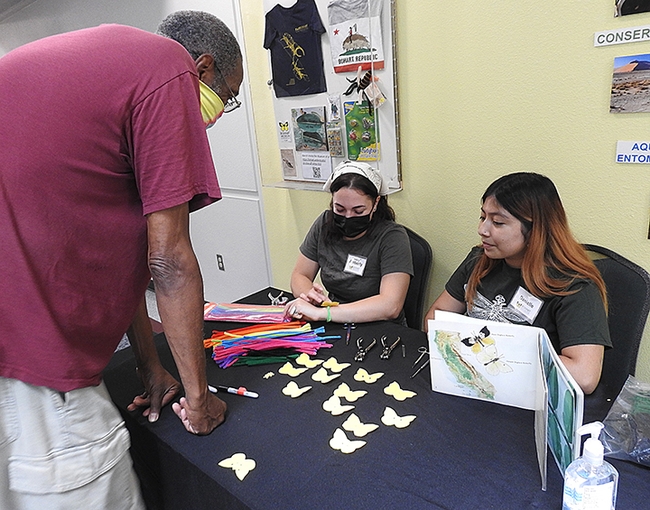

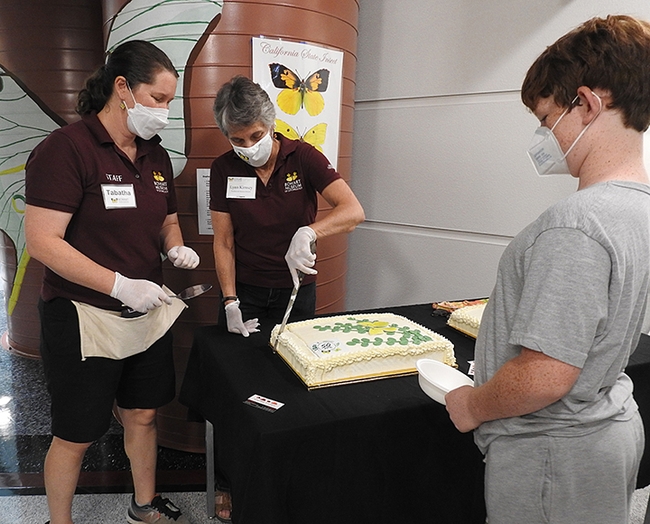
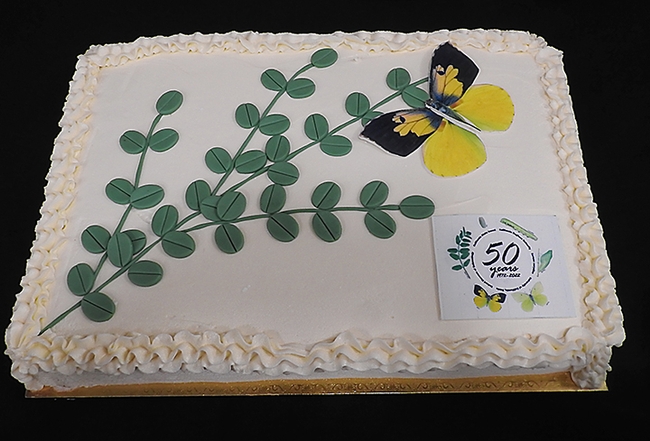
- Author: Kathy Keatley Garvey
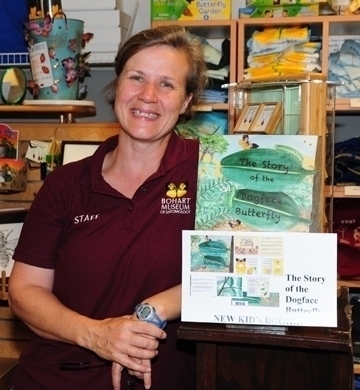
That story will be among the highlights of the Bohart Museum of Entomology open house from 1 to 4 p.m., Saturday, July 16 in Room 1124 in celebration of the 50th anniversary of the year the California State Legislature singled it out to be the state insect.
Professor Fran Keller of Folsom Lake College, a UC Davis doctoral alumnus and author of the children's book, The Story of the Dogface Butterfly, will read the 35-page book to children and parents at 1:30 p.m. and again at 3:30 p.m. in the Wildlife Classroom, Museum of Wildlife and Fish Biology, located next door to the Bohart Museum in the Academic Surge Building.
The book features photos by Bohart associate Greg Kareofelas and Professor Keller, and illustrations by former UC Davis student Laine Bauer. The California dogface butterfly, Zerene eurydice, found only in California, thrives at its major breeding ground, the Shutamul Bear River Preserve, a private preserve maintained by the Placer Land Trust (PLT).
It is there because its host plant, false indigo, Amorpha californica, is there, points out Kareofelas, who has reared multiple California dogface butterflies from egg to caterpillar to chrysalis to adult. He serves as a volunteer docent for the PLT's Shutamul Bear River Preserve.
"Most people have never seen a single dogface butterfly (in the wild)," says Kareofelas. On a June 10th tour of the preserve, held specifically for the Bohart Museum, the group saw 75 to 100 dogface butterflies.
Art Shapiro, UC Davis distinguished professor of evolution and ecology, who has monitored the butterfly populations of Central California for 50 years, said he has never seen 100 Zerene eurydice in his lifetime. He maintains a research site, Art's Butterfly World.
False indigo (Amorpha), its only known host plant, "is a rather inconspicuous shrub found with poison oak, willow, etc. near streambanks, often along boulder-strewn tributary streams in side canyons where access is very difficult," Shapiro says on his website.
The schedule:
1 p.m.: Event starts
Tabling: Placer Land Trust information table, Greg Kareofelas with live caterpillar/rearing project
Activities:
- Craft: Yellow felt dogface butterflies shoe/hair/belt/wrist ornaments
- Craft: Color the dogface butterfly life cycle (paper or for $8.50 for bandanna)
- Craft: Paper caterpillar puppet
- Petting Zoo (Madagascar hissing cockroaches, stick insects, tartantulas)
- Butterfly collection exploration with entomologist Jeff Smith, curator of the Lepidoptera collection
- Butterfly banner photo-op
1:30 p.m.: Professor and author Fran Keller reads The Story of the Dogface Butterfly in the Wildlife Classroom
2:30 p.m.: Communication specialist Julia Boorinakis Harper Barbeau of Placer Land Trust shows four-minute video and Bohart associate Greg Kareofelas gives a talk/powerpoint about the history of the dogface (5-10 minutes) in the Wildlife Classroom
3 p.m.: Celebration dessert in the hallway with Lynn Kimsey, director of the Bohart Museum of Entomology
3:30 p.m.: Professor and author Fran Keller reads The Story of the Dogface Butterfly in the Wildlife Classroom
4 p.m.: Event ends
The Bohart Museum, directed by UC Davis distinguished professor Lynn Kimsey, houses a global collection of eight million insect specimens. It also maintains a live petting zoo and an insect-themed gift shop (including T-shirts, hoodies, books, jewelry, posters, collecting equipment)
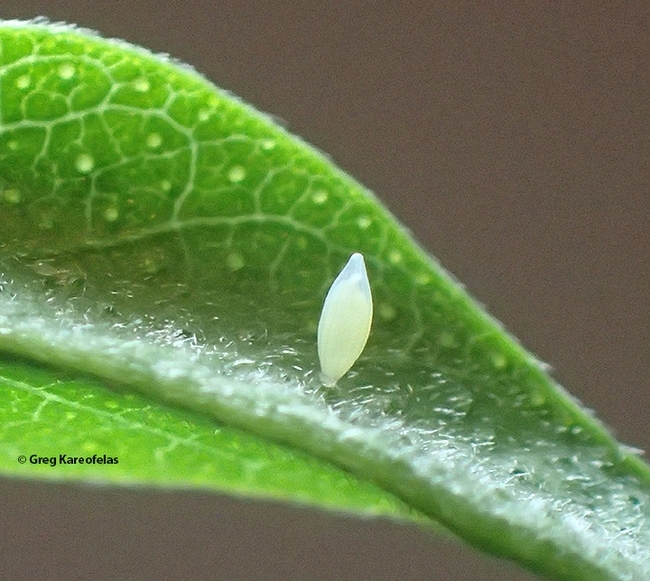
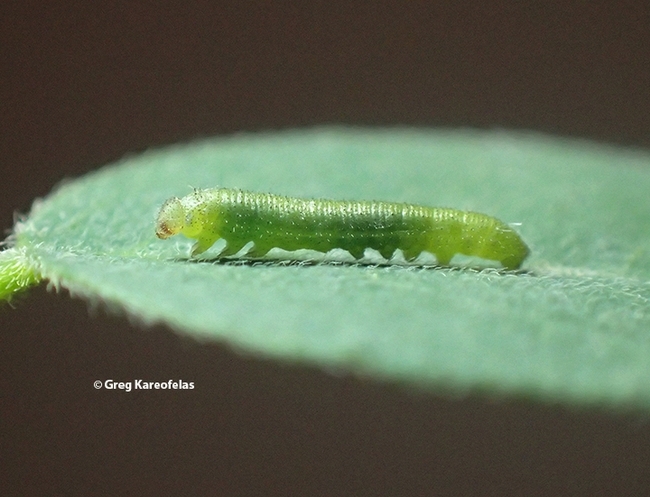
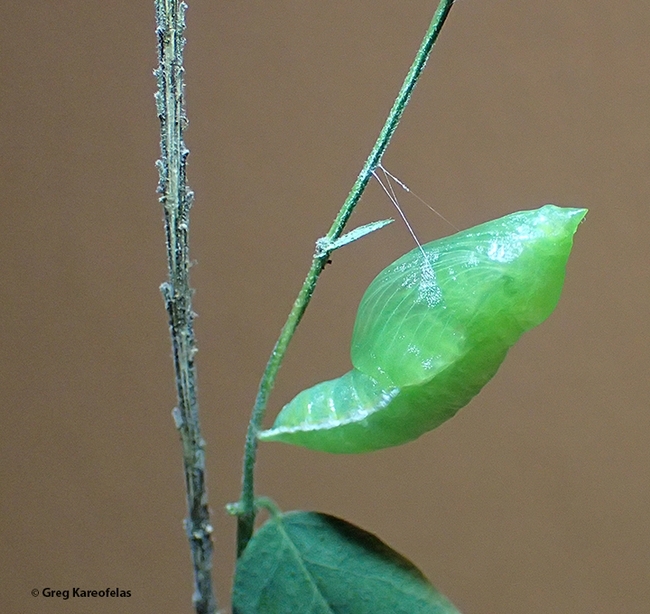
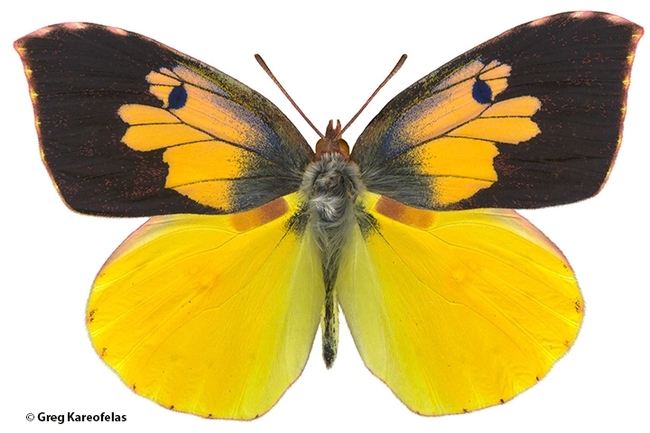
- Author: Kathy Keatley Garvey
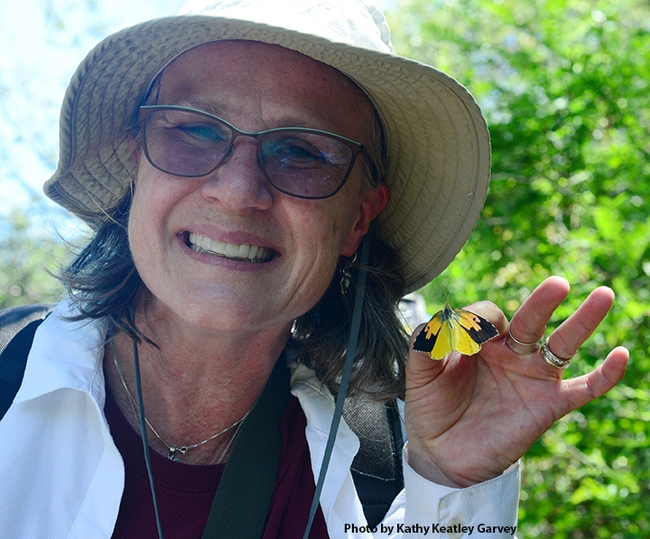
The Land of Z? It's the home or major breeding ground of Zerene eurydice, the California dogface butterfly, the state insect. Where is this major breeding ground: At the 40-acre Shutamul Bear River Preserve, Auburn, maintained by Placer Land Trust (PLT).
The Land of B? That's the Bohart Museum of Entomology at UC Davis, the venue for an open house showcasing the California dogface butterfly. The free and family friendly event will take place July 16 from 1 to 4 p.m. in Room 1124 of the Academic Surge Building, 555 Crocker Lane, UC Davis campus. The crowd will celebrate the 50th anniversary of the year that the California State Legislature designated the dogface butterfly as the state insect.
Officials from both Placer Land Trust and the Bohart Museum will be at the open house to answer questions and provide information about the biology and history of the state insect. There also will be a family arts-and-craft activity.
To prepare for the open house and to gain more scientific knowledge, a Bohart Museum crew toured the "Land of Z" on June 10 (in 100-degree heat) and saw an estimated 75 to 100 dogface butterflies.
"Most people have never seen a single dogface butterfly in the wild, let alone 75 to 100 in one day," said Bohart associate Greg Kareofelas, a Davis-based naturalist who studies the insect and leads volunteer PLT tours. He has reared multiple California dogface butterflies, from egg, to caterpillar to chrysalis to adult, and will show the macro images at the open house.
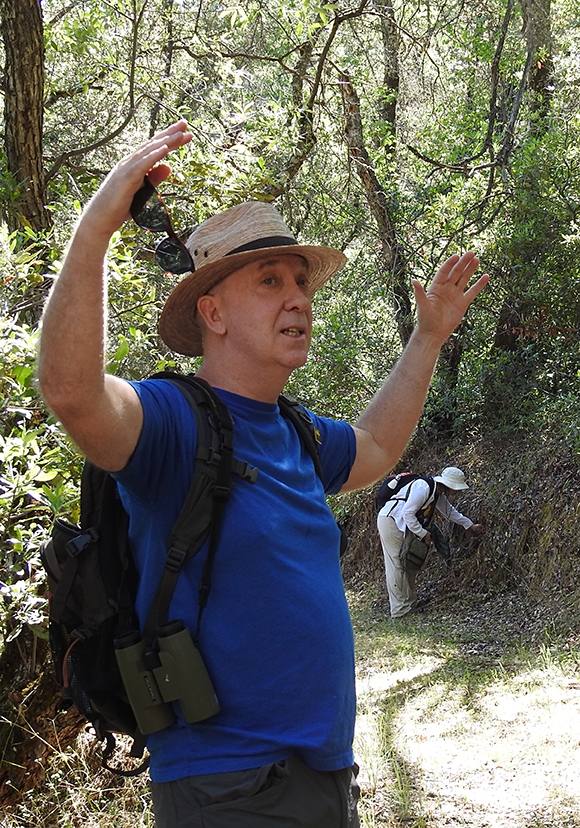
Ross, a self-described naturalist, birdwatcher and "a practicing amateur lepidopterist," learned of the host plant's presence in 2005. If the host plant is there, he figured, the butterfly must be there, too.
Ross visited the site in the fall of 2008 but found only leafless twigs. Further investigation revealed that the "leafless twigs" were, in fact, false indigo, "and it was so abundant on the preserve he was sure the butterfly would be present as well," according to an article on the PLT website. "Ross visited the Shutamul Preserve only once a year for the next two years and during those visits was able to see many dogface butterflies. He later learned from Professor Art Shapiro at UC Davis that the life history of the dogface butterfly was not well understood, especially for the over-wintering adults. Ross saw this as a great opportunity to conduct a scientific study to document the life-cycle of this butterfly."
Found only in California, the rarely seen butterfly is also known as (1) "the flying pansy," referring to the male's spectacular black and yellow coloring, and (2) as a "dog head" butterfly (the markings on the male resemble a silhouette of a dog's head). The female is mostly solid yellow.The dogface butterfly is so named because the wings of the male appear to be a silhouette of a poodle.
Its range spans from San Diego County to Sonoma County, and it is usually found in mountain and foothill locations, according to PLT. UC Davis distinguished professor Art Shapiro of the Department of Evolution and Ecology has recorded multiple sightings of the high-flying butterflies in Gates Canyon in Vacaville in his 50 years of monitoring butterflies in Central California. He has also seen it in his driveway in Davis. But, as Shapiro told us today, "I doubt if I have seen 100 in my entire life." (See his information on Zerene on his research site, Art's Butterfly World.)
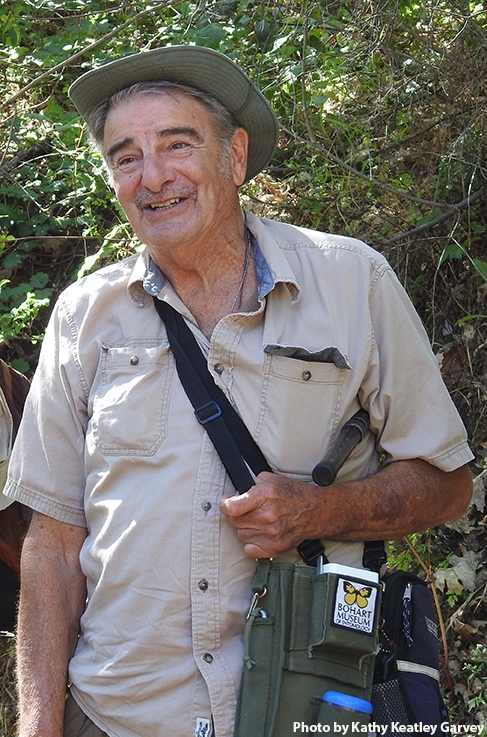
- 2005: The Placer Land Trust acquired the 40-acre property from a willing seller.
- 2005/2006: California Native Plant Society reported false indigo at the Shutamul Bear River Preserve.
- 2007-2008: Deren Ross (accompanied by a PLT crew) discovered the California dogface butterfly there.
- 2011: Butterfly surveys and invitations to folks with an interest in plants and entomology began.
The PLT website reports: "In June 2011, Ross began going out to the Shutamul Preserve weekly to conduct male/female butterfly counts and behavior patterns. It proved to be a very exciting study; eggs were observed being laid on the False Indigo and then caterpillars got busy munching away at the plant. Previous research indicates the butterfly has two broods per year: one brood from April to July (adult life-span 3-4 months) and a second in August to October (adult life-span 6-8 months). The adults from the last brood overwinter in a state of hibernation until emerging again in early spring and mating."
Ross discovered a dogface in "near mint condition" on March 8, 2012. Now he and Kareofelas are investigating whether the dogface overwinters as a chrysalis.
The UC Davis crew on the trip included Tom Zavortink, Bohart research associate and entomologist; Professor Fran Keller of Folsom Lake College, a Bohart scientist; Bohart senior museum scientist Steve Heydon, curator and collections manager; Bohart associate Greg Kareofelas; Bohart lab assistant Brennen Dyer; Tabatha Yang, Bohart education and outreach coordinator; and Kathy Keatley Garvey, communications specialist, Department of Entomology and Nematology. UC Davis distinguished professor Lynn Kimsey, director of the Bohart, which includes a global collection of eight million insect specimens, was unable to attend.
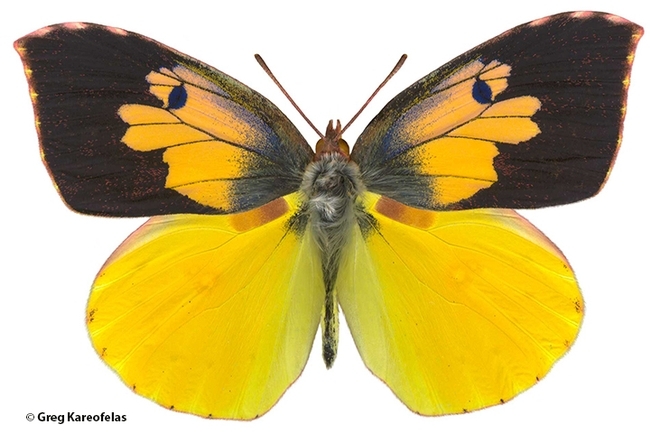
History
California legislators adopted the dogface butterfly as the official state insect on July 28, 1972. But as early as 1929, entomologists had already singled it out as their choice for state insect. Their suggestion appears in the California Blue Book, published by the State Legislature in 1929.(Read more on how the butterfly became the state insect under the Ronald Reagan administration.) In 1972, fourth grade students of Betty Harding and Shirley Klein in the Dailey Elementary School, Fresno, advocated that the butterfly be the state insect. The teachers and students enlisted the help of State Assemblyman Kenneth L. Maddy, who authored AB 1834.
In 2013, Fran Keller, then a doctoral student in entomology at UC Davis, published a 35-page children's book, The Story of the Dogface Butterfly that includes photos by Kareofelas and Keller, and illustrations by then UC Davis student Laine Bauer. The book tells the untold story of the California dogface butterfly, and how the Fresno schoolchildren became involved in convincing the State Legislature to select the butterfly as the state insect. Both the book and a Keller-Kareofelas poster of the male and female butterfly are available for sale in the gift shop at the Bohart Museum.
In 2017 Kareofelas led a tour for the KVIE "Rob on the Road" TV program. It is online at http://vids.kvie.org/video/3002661342/
Although most people have never seen the California dogface butterfly in the wild, they may have noticed a tiny image of the insect on California driver licenses. It also appears on first-class stamps, on the California State Fair monorail, and on a wine label.
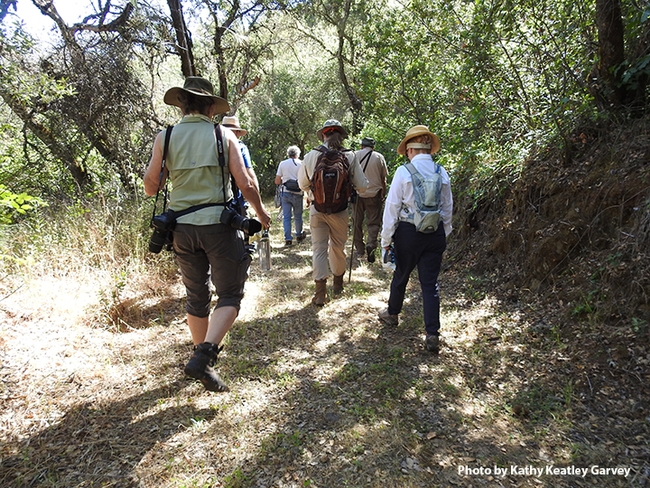
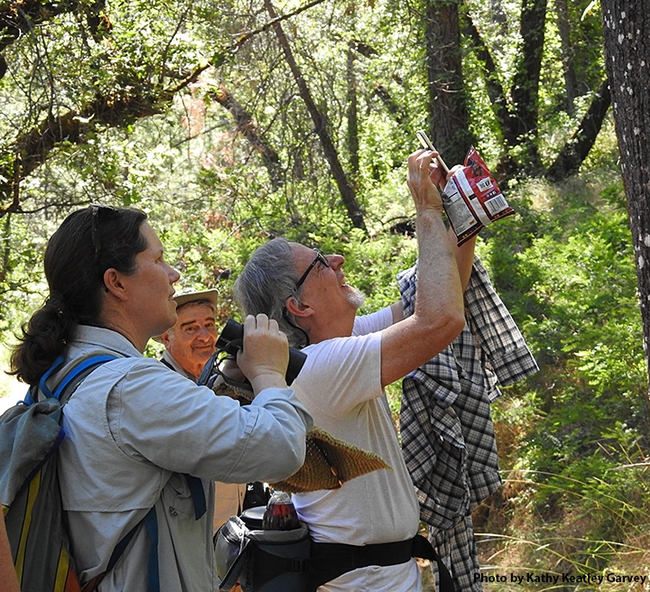
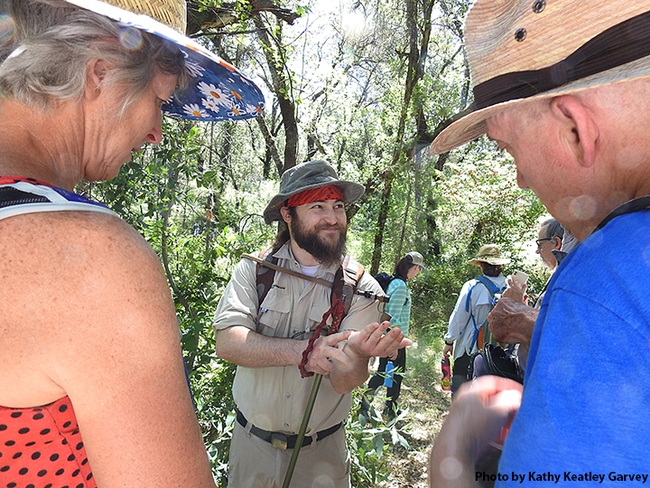
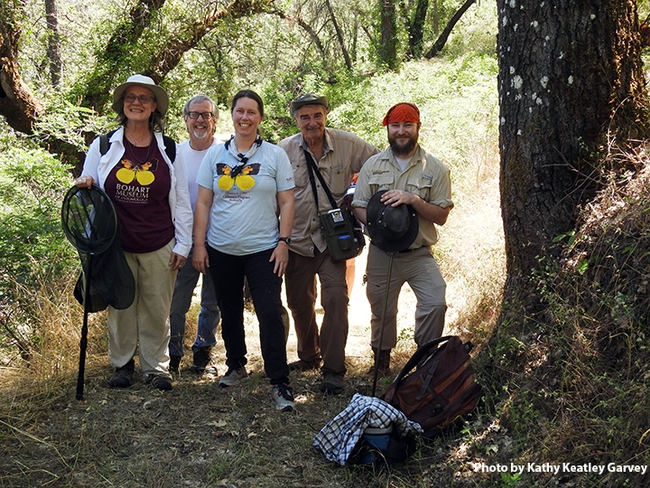
- Author: Kathy Keatley Garvey

But they can't.
So scientists and butterfly enthusiasts will.
The history is intriguing. The State Legislature designated the colorful butterfly, Zerene eurydice, as the state insect 50 years ago, and Gov. Ronald Reagan signed it into law on July 28, 1972.
Found only in California, the rarely seen butterfly is also known as (1) "the flying pansy," referring to the male's spectacular black and yellow coloring, and (2) as a "dog head" butterfly (the markings on the male resemble a silhouette of a dog's head). The female is mostly solid yellow.
The butterfly's major breeding ground is in Auburn in the Shutamul Bear River Preserve maintained by the Placer Land Trust (PLT). The butterfly is there because its larval host plant--false indigo (Amorpha californica)--grows well there. "The dogface butterfly has a range from San Diego County to Sonoma County and is usually found in mountain and foothill locations," according to an article on the PLT website. (Watch a virtual tour at https://youtu.be/kJUk1AKGtKs)
Meanwhile, the folks at the Bohart Museum of Entomology, including director Lynn Kimsey, museum scientist Fran Keller and Bohart associate Greg Karofelas (he shares his expertise as a docent leading tours and delivering presentations for the Pacific Land Trust), hope to connect with the fourth grade students of Betty Harding and Shirley Klein in the Dailey Elementary School, Fresno, who advocated it as the state insect. The teachers and students enlisted the help of State Assemblyman Kenneth L. Maddy, who authored AB 1834. "His bill was read for the first time on March 15, 1972 and referred to the Assembly Committee on Government Organization, according to a state website.
"On May 25, 1972, with a committee vote of 6-2, Mr. Maddy failed to garner the needed eight votes to recommend the legislation to a floor vote. It wasn't clear why two members voted against the bill, but a bill to designate an official state fossil also gone down to defeat earlier in the day.
"The Fresno Bee wrote, 'Dog-Faced Butterfly Has Wings Clipped.'
"Assemblyman Maddy vowed to fight on and promised a better result when the full committee was present in the next week.
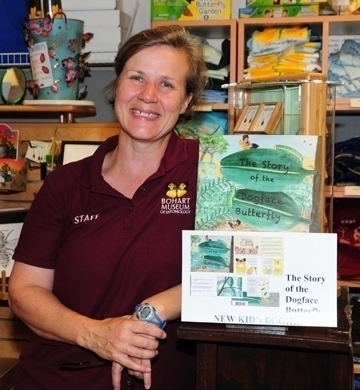
"A month later, on July 20, the Senate voted 29-0 to approve AB 1834.
"On July 28, 1972, Governor Ronald Reagan signed Assembly Bill No. 1834 designating the California dog-face butterfly the official State Insect of California." (Read more on how the butterfly became the state insect under the Ronald Reagan administration.)
The fourth graders, who were then about 10 or 11 years old, are now in their early 60s. Where are they? The folks at the Bohart Museum want to know--they'd love some first-hand information on how the project originated and why. Perhaps they could be involved in a 50th year celebration!
In 2013, Fran Keller, a UC Davis doctoral alumnus and now a professor at Folsom Lake College, published a 35-page children's book, The Story of the Dogface Butterfly that includes includes photos by Kareofelas and Keller and illustrations by then UC Davis student Laine Bauer. They earlier created a poster. Both the book and the poster are available for sale in the online gift shop at the Bohart Museum (The Bohart, located in Room 1124 of the Academic Surge Building on the UC Davis campus, is temporarily closed to the public due to the COVID pandemic and campus policies.) Net proceeds benefit the insect museum's education, outreach and research programs.
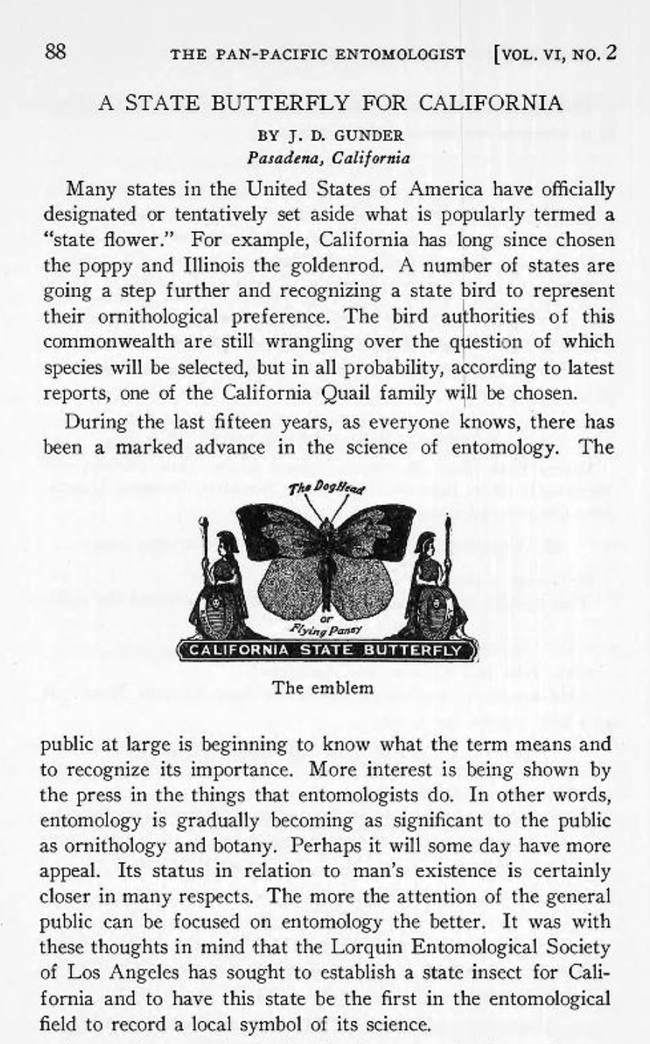
Kareofelas has assisted with news documentaries on the butterfly:
- Rob on the Road, KVIE, Public Broadcasting Service (PBS)
- Capital Public Radio, National Public Radio (NPR)
The history of how the butterfly became the state insect actually begins in the 1920s with the Lorquin Entomological Society of Los Angeles. In an October 1929 article in The Pan-Pacific Entomologist, a publication of the Pacific Coast Entomological Society, J. D. Dunder of Pasadena credits the Lorquin Entomological Society with seeking "to establish a state insect for California." Out of three choices, the group voted on the California dogface butterfly.
Dunder wrote that the butterfly is "strictly a native California butterfly" and that "thousands of specimens are used each year in entomological art work for trays, bookends, plaques, etc., so the species is already fairly well known to the pubic."
Today its image graces a first-class U.S. stamp and our California driver licenses. It's also depicted on the California State Fair monorail. The Lone Buffalo Vineyards and Winery, Auburn, memorialized it on labels of specially bottled wine, with proceeds helping conservation efforts of the Placer Land Trust to protect the butterfly. It is, indeed, a spectacular butterfly.
Now the question is, why did the fourth graders pursue the project? The butterfly is not found in Fresno. Who or what inspired them? And why?
Anyone know?
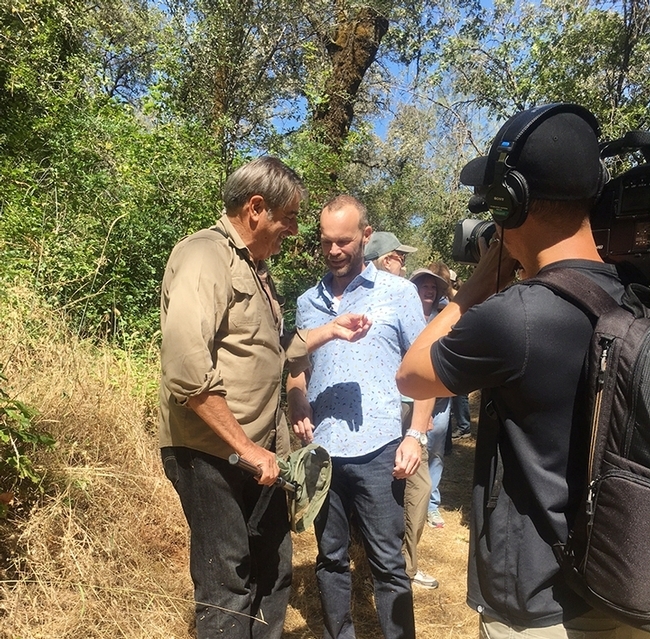
- Author: Kathy Keatley Garvey
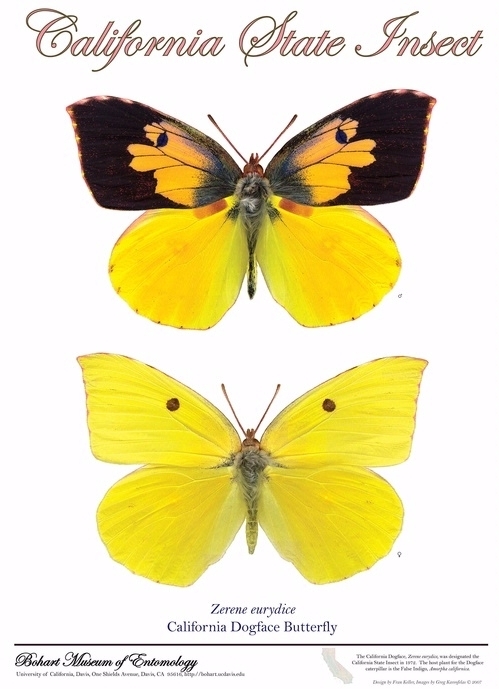
Naturalist Greg Kareofelas, an associate of the UC Davis Bohart Museum of Entomology and an expert on the California state insect, the dogface butterfly, appeared several years ago on a segment of the PBS program, "Rob on the Road."
In a surprising case of recollection, someone at a Sacramento yard sale recognized him from the TV show and said "The Dogface Butterfly Guy!"
That he is.
And if you missed the program, it's scheduled to be broadcast again on Monday night, Aug. 30 on PBS (at 7:30 p.m. locally). It's also online at http://vids.kvie.org/video/3002661342/.
"We had a lot of fun doing that segment," Kareofelas recalled.
The California dogface butterfly, Zerene eurydice, is found only in California. It thrives in the 40-acre Shutamul Bear River Preserve near Auburn, Placer County. The preserve, part of the Placer Land Trust, is closed to the public except for specially arranged tours.
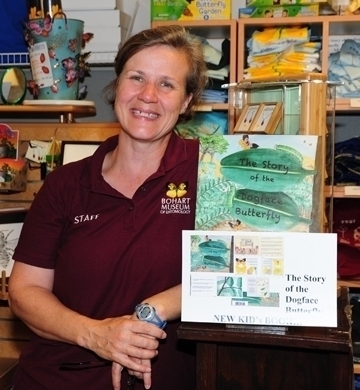
The dogface butterfly is so named because the wings of the male appear to be a silhouette of a poodle. It is also known as "the flying pansy."
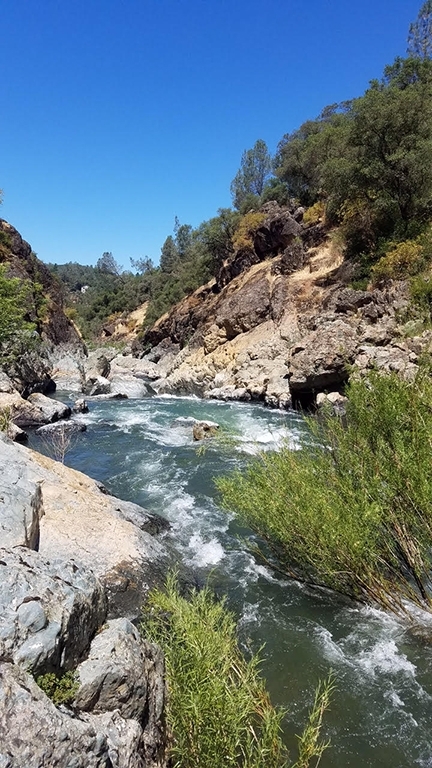
We wrote about Greg Kareofelas and the "Rob on the Road" TV program on Bug Squad in 2017.
We also mentioned the 35-page children's book, The Story of the Dogface Butterfly, the work of entomologist and author Fran Keller, with photographs by Kareofelas and Keller, and illustrations by former UC Davis student Laine Bauer. The trio visited the Auburn site for their research, and Kareofelas also reared a dogface butterfly at his home in Davis and photographed the life cycle. Keller, now a Folsom Lake College professor, holds a doctorate in entomology from UC Davis. She studied with major professor Lynn Kimsey, director of the Bohart and UC Davis distinguished professor of entomology.
Kareofelas and Keller also teamed to create a dogface butterfly poster of the male and female. Both the book and the poster are available online from the the Bohart Museum of Entomology gift shop. The facility is closed to the public due to COVID-19 pandemic precautions.
Why does the butterfly thrive in Auburn? Because its larval host plant--false indigo, Amorpha californica--is there. The plant is difficult to grow outside this habitat, according to Placer Land Trust manager Justin Wages. Perhaps, he says, it's the unique geography and soil near the Bear River.
Think you've never seen the California state insect? Chances are, you have. A tiny image appears on all California driver's licenses and it's also a first-class stamp.
